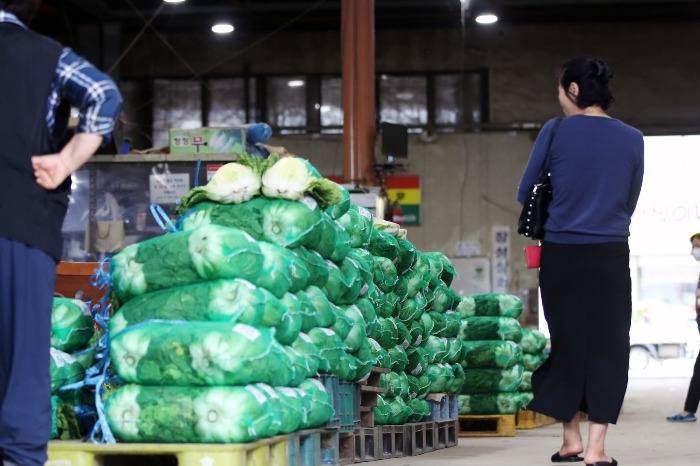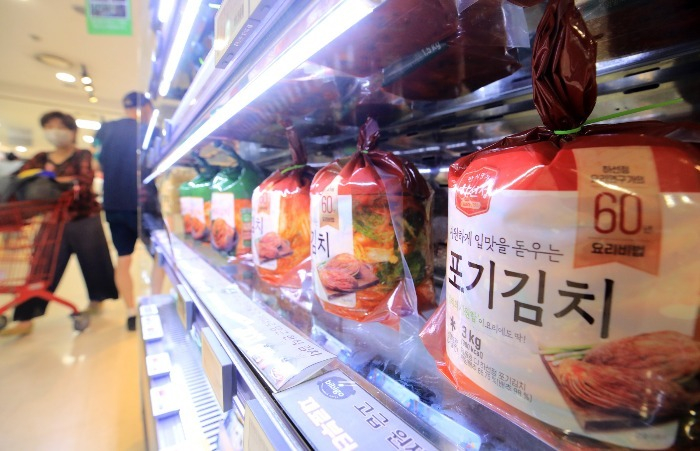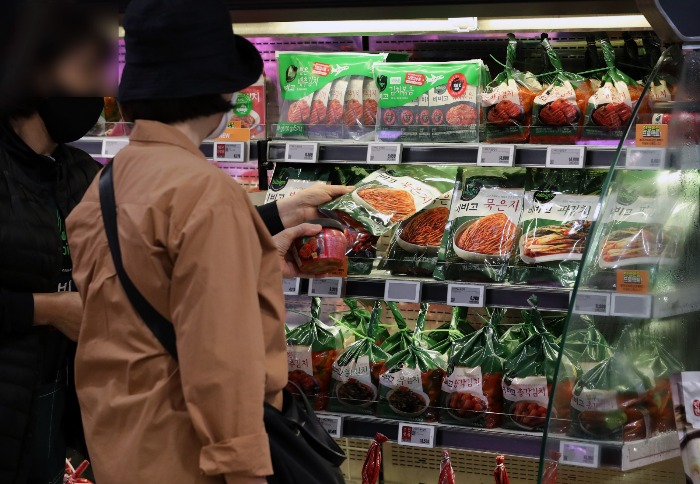Price of napa cabbage, key kimchi ingredient, keeps soaring
The surge in the price of napa cabbage has led to record-high demand for the fermented dish sold at retailers
By Sep 16, 2022 (Gmt+09:00)
LG Chem to sell water filter business to Glenwood PE for $692 million


Kyobo Life poised to buy Japan’s SBI Group-owned savings bank


KT&G eyes overseas M&A after rejecting activist fund's offer


StockX in merger talks with Naver’s online reseller Kream


Mirae Asset to be named Korea Post’s core real estate fund operator



The price of napa cabbage continues to soar in South Korea.
Hit by heavy rainfall during its harvest season, Gangwon Province suffered from a lackluster cabbage harvest this year.
The surge in the price of napa cabbage, the main ingredient for Korea's staple side dish of kimchi, has led to unprecedentedly high demand for the fermented dish at both online and offline retailers.
PRICIEST IN A DECADE
The wholesale price of napa cabbage stands at 1,894 won ($1.36) per kilogram on Friday according to the Korea Agricultural Product Price Index (KAPI), a 10.3% increase from a week earlier.
When compared with the August average, the price jumped 64.7% — and a whopping 128% from the same month last year.
The wholesale price of daikon radishes, another important ingredient in kimchi, rose to its highest in a decade this month: 1,728 won ($1.24) per kilogram.
The average wholesale price of napa cabbage in September over the past 10 years was 938 won per kilo.
The average wholesale price of daikon radish this month rose 16% compared with August and 169% over the same month last year.
The heat wave and frequent rainfall, coupled with Typhoon Hinnamnor, wreaked havoc on the country's napa cabbage harvest.
“The napa cabbage currently available for sale were harvested from the highlands of Gangwon Province, 600 meters above sea level,” a buyer for a major food retailer told The Korea Economic Daily. “The volume of napa cabbage from the highlands dropped significantly due to worsened weather conditions, leading to a rapid price increase.”

SOLD OUT
The rise in the price of the main ingredient for kimchi is also pushing up the price of packaged kimchi, at a time when more people find it economical to buy the ready-to-eat product than make the Korean staple at home.
Thanks to such high demand, packaged kimchi is sold out on many online e-commerce platforms.
Daesang Corp.’s online mall Jungone e-shop has been out of stock of some types of kimchi, from the most common napa cabbage to the spring onion variety, for about a month.
CJ CheilJedang Corp. also stopped selling the Bibigo brand of napa cabbage kimchi on its CJ The Market website and app.
At brick-and-mortar stores, major retailers such as E-Mart, Lotte Mart, and Homeplus are seeing empty shelves for kimchi by afternoon.
A Daesang employee explained the company had to stop selling kimchi online after demand surged in mid-August, and instead focus on supplying offline retailers.
A CJ employee said that even major food companies are suffering from a shortage of napa cabbage for making kimchi.
Both Daesang and CJ CheilJedang have said they will raise prices for packaged kimchi under their respective brands, Jongga and Bibigo, by about 10% as early as this week.

TO STABILIZE BEFORE NOVEMBER
To make up for the supply shortfall at home, Korean companies are importing more kimchi from China.
The Korea Customs Service announced that the monetary value of kimchi made in China reached $19.86 million so far this year, a 27.6% jump from the same period last year.
The value of imported kimchi in August rose 41.1% from the same month last year to $13.38 million.
Industry insiders said the price of napa cabbage should stabilize before November, when kimchi-making season kicks off across the peninsula.
The Ministry of Agriculture, Food and Rural Affairs announced that prices will stabilize when the napa cabbage harvest from regions at altittudes of 400 to 600 meters above sea level begins.
Around 968 hectares of napa cabbage are under cultivation in these semi-highland areas, according to the Korea Rural Economic Institute, up 10.4% from the average year.
Wholesale napa cabbage prices are forecast to drop to 725 won per kilogram next month and fall further to 487 won per kilogram in November.
Write to Jong-Kwan Park at pjk@hankyung.com
Jee Abbey Lee edited this article.
-
 Korean foodWashington D.C. recognizes Korea as origin of kimchi
Korean foodWashington D.C. recognizes Korea as origin of kimchiJun 29, 2022 (Gmt+09:00)
1 Min read -
 Monthly trade infographicsKimchi on track for first trade surplus in 12 years
Monthly trade infographicsKimchi on track for first trade surplus in 12 yearsDec 09, 2021 (Gmt+09:00)
2 Min read


